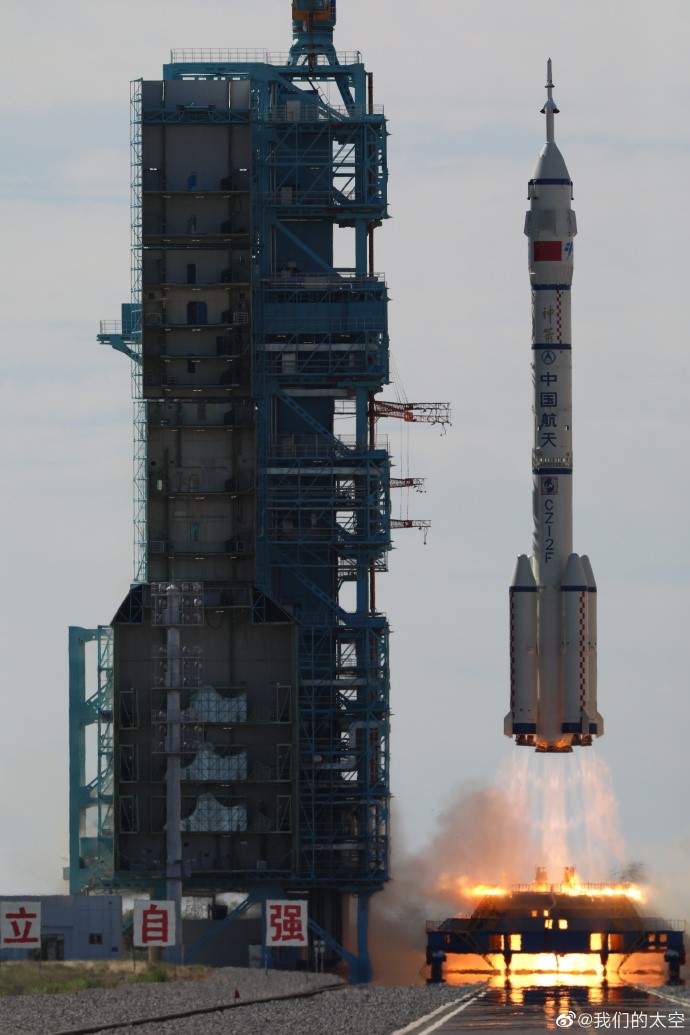Three astronauts enter Tianhe core module of China’s space station
Chinese astronauts Nie Haisheng, Liu Boming, and Tang Hongbo onboard China's Shenzhou-12 spaceship entered the Tianhe core module of the country's space station at 18:48 on June 17, 2021 Beijing time after Shenzhou-12 completed a fast automated rendezvous and docking with the orbiting Tianhe module, which marked the first time the Chinese have entered their own space station.
The crewed Shenzhou-12 spaceship, atop a Long March-2F Y12 carrier rocket, was launched at 9:22 a.m. on June 17 from the Jiuquan Satellite Launch Center in northwest China’s Gobi Desert as planned.
About 573 seconds later the spaceship separated from the rocket and entered its designated orbit. The Shenzhou-12 crew is in good condition and the launch is proven a complete success.
The three astronauts are expected towork and sleep according to Beijing time, and stay at the space station for three months. They will return to the Dongfeng landing site in north China’s Inner Mongolia autonomous region aboard the return capsule of Shenzhou-12.
The Shenzhou-12 manned spaceflight mission is the fourth spaceflight mission in the stage for the verification of key technologies and the first manned spaceflight mission during the construction of China’s space station.
The mission will further verify the functions and performance of the manned space transport system and astronauts’ ability to complete extravehicular activities and operations in orbit with the robotic arm. It will also comprehensively verify various technologies that help guarantee astronauts’ long-term in-orbit stay, including those related to the Bioregenerative Life Support System (BLSS), supply of goods and materials in space, as well as astronauts’ health management.
China has planned two extravehicular activities for the Shenzhou-12 manned spaceflight mission, said Ji Qiming, assistant to the director of the China Manned Space Engineering Office (CMSEO).
According to him, astronauts will first perform extravehicular activities for a relatively long time, including assembling equipment, repairing and maintenance operations, and the mission will for the first time examine the astronaut research and rescue capabilities at the Dongfeng landing site.
Among the crew members of the Shenzhou-12 spaceship, Nie, the commander of the mission, has been to space twice in the Shenzhou-6 mission in 2005 and the Shenzhou-10 mission in 2013. Liu has participated in the Shenzhou-7 mission in 2008, while Tang is a newcomer to space.
The significantly increased extravehicular time and multiple extravehicular activities and operations would make the mission more complicated and challenging, said Liu at a press conference on June 16. That's why he and his fellow astronauts have undergone strict, systematic, and comprehensive training, he added.
“I firmly believe that with professional ground support and close cooperation among the crew members, we will be able to meet challenges with full confidence, no matter how difficult, risky, and heavy our tasks will be,” Liu said.
“We will successfully complete each extravehicular activity, especially under the protection of the domestically developed new-generation extravehicular spacesuit. There will definitely be more Chinese marks in the vast space,” he said.
According to China’s plan for the construction of its space station, a total of 11 spaceflight missions have been scheduled for this year and the next, including three launches of space station modules, four cargo vessel flights, and four manned missions.
The in-orbit construction of the space station is expected to be completed by 2022. Upon the completion of the country’s national space laboratory, the space station will be applied to use and embrace further development.
 |
Photos
Related Stories
- Shenzhou-12 astronauts enter space station core module
- China's space station core module receives first group of residents
- China's Shenzhou-12 manned spaceship docks with space station module
- China launches first crewed mission for space station construction
- Chinese astronauts ready for in-orbit space station construction
- China unveils Shenzhou-12 astronauts for space station construction
- China's first crewed space station mission draws closer
- Effective power supply energizes China's space station project
- SpaceX launches tiny critters, solar panels to space station
- China launches cargo craft for space station supply, refueling mission
Copyright © 2021 People's Daily Online. All Rights Reserved.











